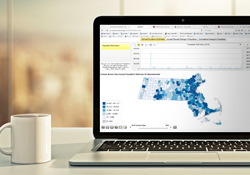Massachusetts Population Estimates by City and Town

On May 15, 2025, the U.S. Census Bureau released updated population estimates for Massachusetts cities and towns (also called “minor civil divisions” or “MCDs”) for July 1, 2024. This new vintage of estimates is derived from the allocation of the Census Bureau’s 2024 county-level population estimates, released on March 13, 2025, to individual municipalities.
According to the U.S. Census Bureau’s 2024 Sub-County Population Estimates, all 26 of Massachusetts’ cities or towns with populations of 50,000 or more in 2020 increased in population from July 1, 2023 to July 1, 2024. Boston led the group in terms of total population gained with an estimated 8,855 person increase over the year. Revere was the fastest-growing large place in terms of percentage growth, with a 2.9% population increase.
Boston, in both 2023 and 2024, reversed its decrease in population that was estimated from Census 2020 through July 1, 2022 due to the record high international migration levels seen in Massachusetts in the latest Census estimates. In addition, net domestic out-migration has rebounded to pre-pandemic levels, leading to sizeable population increases in Suffolk County and in Boston. Domestic outmigration has slowed over the last two years in the rest of the state, contributing to population increase in all of the largest places in Massachusetts.
Among all 351 individual cities and towns in Massachusetts, the U.S. Census Bureau estimates that 283 municipalities, or 81%, increased in population between July 1, 2023 and July 1, 2024. Again, here we see the effects of an increasing international migration component in the county-level estimates to which the municipal estimates are controlled. After Boston, the largest population gains from 2023 to 2024 were estimated in Worcester (2,075), Cambridge (1,871), and Woburn (1,812), representing a balanced increase in population in both larger cities as well as smaller, mid-size, and larger towns.
The Vintage 2024 population estimates for cities and towns reflect the broader trends observed in the county-level estimates released in March 2025. In Bristol, Dukes, Hampden, Nantucket, Norfolk, Plymouth, Suffolk, and Worcester Counties — all counties which gained population in the V2024 estimates — 100% of the cities and towns gained population. Essex County and Middlesex County saw 97% and 98% of their cities and towns gain population in the V2024 Estimates series, respectively.
In the three counties that lost population this year, 8 out of 15 (53%) Barnstable towns gained population, 8 out of 32 (25%) of Berkshire towns gained population, and 4 out of 20 (20%) of Hampshire towns gained population. Franklin County, while gaining a mere 11 people in the V2024 estimates, only saw 7 of its 26 towns (27%) gain population.
For detailed information about the Vintage 2024 city and town population estimates, access the interactive dashboard and full UMDI report below.

